A condensation reaction of 2,3,5,6-tetraamino-1,4-benzoquinone
1 with 4,5-Dichloro-3,6-dihydroxy-phthalonitrile
2 produced p-benzoquinone [2,3-b:2,3-b]bis[(5,8-dihydroxybenzopyrazine)-6,7-dinitrile]
3. Utilizing acetic acid with lithium/pentanol, the tetra-nitrile monomer was cyclo-tetramerized, yielding the matching network polymer, tetra p-benzoquinone[2,3-b:2,3-b]. bis[(5,8-dihydroxybenzopyrazino) porphyrazine (2H-Pz)
4a. The equivalent tetra p-benzoquinone[2,3-b:2,3-b]bis[(5,8-dihydroxybenzopyrazino) metallic porphyrazine networks
[...] Read more.
A condensation reaction of 2,3,5,6-tetraamino-1,4-benzoquinone
1 with 4,5-Dichloro-3,6-dihydroxy-phthalonitrile
2 produced p-benzoquinone [2,3-b:2,3-b]bis[(5,8-dihydroxybenzopyrazine)-6,7-dinitrile]
3. Utilizing acetic acid with lithium/pentanol, the tetra-nitrile monomer was cyclo-tetramerized, yielding the matching network polymer, tetra p-benzoquinone[2,3-b:2,3-b]. bis[(5,8-dihydroxybenzopyrazino) porphyrazine (2H-Pz)
4a. The equivalent tetra p-benzoquinone[2,3-b:2,3-b]bis[(5,8-dihydroxybenzopyrazino) metallic porphyrazine networks (M-Pz) M = Zn
4b or Ni
4c, were obtained by cyclo-tetramerizing the tetra-nitril monomer 3 using metal salt and quinoline. The synthesized molecules’ elemental analytical results, as well as their IR and NMR spectral data, are consistent with their assigned structures. The prepared compounds have large molecular weights and metal content, indicating that reactions of tetramerization, polymerization, and chelation were all productive. The synthesized porphyrazines were proved to be excellent substrates for oxidizing thiophenol and benzyl thiol to their respective disulfides in atmospheric oxygen. The maximal production of the corresponding disulfides after 15 min was 96 percent for thiophenol and 93 percent for benzyl thiol, respectively.
Full article





